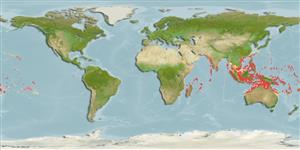>
Anguilliformes (Eels and morays) >
Muraenidae (Moray eels) > Muraeninae
Etymology: Rhinomuraena: Greek, rhinos = nose + Latin, muraena = morey eel (Ref. 45335).
More on author: Garman.
Environment: milieu / climate zone / depth range / distribution range
Ekologi
laut berasosiasi dengan karang; nir-ruaya; kisaran kedalaman 1 - 67 m (Ref. 90102). Tropical; 32°N - 26°S
Indo-Pacific: East Africa to the Tuamoto Islands, north to southern Japan, south to New Caledonia and French Polynesia; including Marianas and Marshalls.
Length at first maturity / Size / Weight / umur
Maturity: Lm 107.0, range 94 - 120 cm
Max length : 130 cm TL jantan/; (Ref. 2334)
Duri punggung (Keseluruhan (total)): 0; Duri dubur 0; vertebrata, bertulang belakang: 270 - 286. Has three fleshy tentacles on the tip of its lower jaw, a single fleshy pointed projection at the tip of its snout, and tubular anterior nostrils ending in gaudy, fanlike expansions.
Adults occur in lagoon and seaward reefs. They are secretive species normally hidden in sand or rubble, sometimes with only its head protruding. Feed on small fishes (Ref. 9710, 48635, 75154, 89972). Juveniles all black, males have yellow dorsal fin and females change to a nearly all yellow color, but usually with blue in the posterior (Ref. 48635). Only moray that undergoes abrupt changes in coloration and sex: it is a protandrous hermaphrodite, i.e., functioning males reverse sex to become females. Protandry is diagnosed based on colouration, but not confirmed (Ref. 103751).
Protandry is diagnosed based on colouration, but not confirmed (Ref. 103751).
Chen, H.-M., K.-T. Shao and C.T. Chen, 1994. A review of the muraenid eels (Family Muraenidae) from Taiwan with descriptions of twelve new records. Zool. Stud. 33(1):44-64. (Ref. 6934)
Status IUCN Red List (Ref. 130435)
ancaman kepada manusia
Harmless
penggunaan manusia
Akuarium: Komersial
informasi lanjut
AcuanBudidaya airprofil budidaya airStrainGenetikaElectrophoresesDiturunkanPenyakit-penyakitPengolahanNutrientsMass conversion
mitraGambarStamps, Coins Misc.Suara-suaraCiguateraKecepatanTipe renangArea insangOtolithsOtakPenglihatan / visi
Alat, peralatan
laporan khas
muat turun XML
Sumber internet
Estimates based on models
Preferred temperature (Ref.
123201): 24.6 - 28.8, mean 27.5 °C (based on 552 cells).
Phylogenetic diversity index (Ref.
82804): PD
50 = 1.0000 [Uniqueness, from 0.5 = low to 2.0 = high].
Bayesian length-weight: a=0.00050 (0.00025 - 0.00101), b=3.26 (3.10 - 3.42), in cm total length, based on LWR estimates for this (Sub)family-body shape (Ref.
93245).
Trophic level (Ref.
69278): 4.5 ±0.80 se; based on food items.
Daya lenting (Ref.
120179): sangat rendah, Waktu penggandaan populasi minimum lebih dari 14 tahun (Preliminary K or Fecundity.).
Fishing Vulnerability (Ref.
59153): Very high vulnerability (78 of 100).
Nutrients (Ref.
124155): Calcium = 22.6 [12.0, 35.3] mg/100g; Iron = 0.436 [0.257, 0.889] mg/100g; Protein = 18.8 [16.6, 21.4] %; Omega3 = 0.102 [0.046, 0.293] g/100g; Selenium = 49.2 [25.9, 97.7] μg/100g; VitaminA = 86.8 [25.0, 291.3] μg/100g; Zinc = 0.721 [0.498, 1.001] mg/100g (wet weight);
